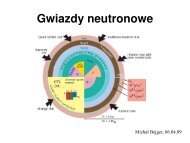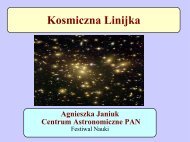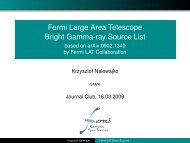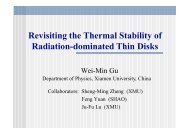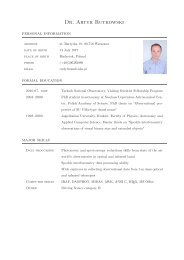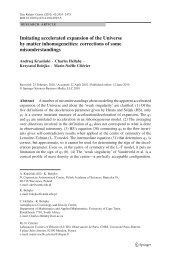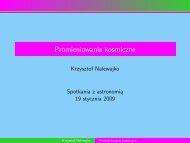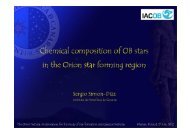Editorial note to: HP Robertson, Relativistic cosmology - Users' Pages
Editorial note to: HP Robertson, Relativistic cosmology - Users' Pages
Editorial note to: HP Robertson, Relativistic cosmology - Users' Pages
Create successful ePaper yourself
Turn your PDF publications into a flip-book with our unique Google optimized e-Paper software.
<strong>Edi<strong>to</strong>rial</strong> <strong>note</strong> <strong>to</strong>: H. P. <strong>Robertson</strong>, <strong>Relativistic</strong> <strong>cosmology</strong> 2101leaving. He defines a <strong>to</strong>tal mass M and energy E (3.5) for such a volume, the lattergenerally not being constant because it is composed of both matter and radiation [see(9.1)]; rather it satisfies the thermodynamic law (3.6), which follows from the conservationequation (3.3). Neither M nor E is constant if matter is transformed in<strong>to</strong>radiation [see (9.9)].At this point no equations of state have been given for the matter, so <strong>Robertson</strong> suggestsrunning the field equations backwards <strong>to</strong> determine the density ρ and pressurep from arbitrary k, λ, and R(t) but subject <strong>to</strong> the inequality p ≥ 0. He then quicklyretreats from this proposal, 4 which is currently highly disfavored because it producesnon-physical solutions of the field equations, and proposes integration of the Friedmannequation [the first of (3.2)] <strong>to</strong> give t(R) by the quadrature (3.7,3.8), with Egiven by (3.5). Before turning <strong>to</strong> solutions, he shows how <strong>to</strong> integrate timelike andnull geodesics, the latter giving a velocity-distance relation (4.6) leading <strong>to</strong> a linearredshift-distance relation (4.9) given in terms of spatial distance l and the wavelengthchange λ/λ. 5 He then identifies the existence of observational limits, characterizedby the radius l(t) of the observable universe at time t. 6 He comments on being able <strong>to</strong>see round the universe if k =+1 and one has the elliptical identification, and introducesthe idea of luminosity distance in (4.12). Thus the basics of cosmological magnituderedshif<strong>to</strong>bservations are all there; but no expressions are given for number counts. 73 SolutionsTurning <strong>to</strong> solutions of these equations, <strong>Robertson</strong> derives the Einstein static solutionfor matter with arbitrary pressure. It obeys2λ = κ(ρ 0 c 2 + 3p 0 ), 2k/R 2 0 = κ(ρ 0c 2 + p 0 ), (2)showing that necessarily λ>0, k =+1, ifρ grav := (ρ 0 c 2 + 3p 0 ) ≥ 0, (3)ρ inert := (ρ 0 c 2 + p 0 ) ≥ 0 (4)respectively. He calculates its radius from Hubble’s value for the density of matter 8and determines the time for light <strong>to</strong> circumnavigate it, and shows how <strong>to</strong> represent it4 Nowadays called the Synge trick or Synge’s g-method.5 The paper preceded the definition of redshift z in current use <strong>to</strong>day. His expression only reduces <strong>to</strong> zeroas l → 0ifv 0 = 0orv 0 = 2c; also the second order term in (4.9) is not the observationally determinabledeceleration parameter, as suggested by his comment at the <strong>to</strong>p of page 69. These issues were sorted outlater by McVittie, McCrea, and Heckmann.6 He is in effect defining the particle horizon, which was the subject of much confusion until its naturewas cleared up by Rindler in 1956 [45]. Similarly, in the paragraph after (6.4), <strong>Robertson</strong> refers <strong>to</strong> the eventhorizon in the de Sitter spacetime, without giving it any name. The name, and explanation, were given laterin the same paper by Rindler.7 See Sandage [51] for a derivation of all these results.8 Somewhat higher than present estimates.123



